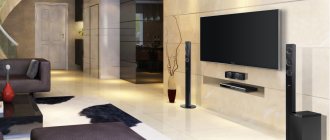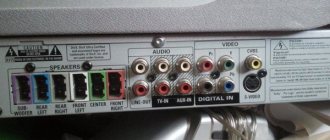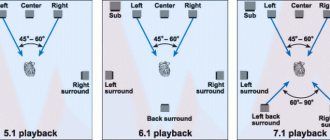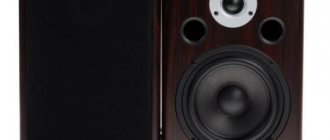Simulating complete immersion while watching a movie is something that avid moviegoers appreciate. Surround sound, a large screen with a clear picture and a 3D effect can create the desired atmosphere. Modern cinemas have long been providing their customers with the opportunity to feel the emotions of the main characters, get the same emotions and watch the progress of the plot as if from inside the film. But what to do if you want to enjoy the same quality of films at home? The answer is simple - buy your own home theater instead of the usual TV. At the same time, when choosing such equipment, it is important to take into account the many nuances of the operation and characteristics of various models, and to make the right decision, study the rating of the best manufacturers.
What is home cinema
A home theater is a system of interconnected multifunctional equipment that allows you to watch movies, listen to music and even play various games. The quality of sound and image is comparable to watching films in a full-fledged cinema.
The standard home theater complex includes:
- TV;
- acoustic system;
- receiver;
- DVD player or Blu-Ray.
Many more devices can be added to this set depending on the budget and needs of the buyer.
There are two options for choosing a mini-cinema for an apartment or house:
- Prefabricated, the elements of which were purchased separately;
- Closed or “in one box”, purchased from a specific manufacturer.
Typical home theater lineup
In the first case, it is possible to select the most optimal components in terms of price and functionality. However, difficulties may arise with the compatibility of devices (you may have to purchase additional adapters, adapters, etc.) and the selection of equipment in the same style.
The second option is simpler, saves time and often money. Suitable for those who don’t really bother with various technical characteristics and just want to purchase a high-quality ready-made home theater.
Main selection criteria
You should not choose such expensive equipment only on the recommendations of consultants.
It is imperative to understand which characteristics presented in the device passport are an indicator of quality, and which are just a marketing ploy.
To begin with, you can study the parameters for choosing the main components of a home theater.
Player selection
There are two types of home theater players: DVD and Blu-Ray. They differ in the way they record information - for “dividishniks” this happens using an infrared ray, for Blu-Rays using a blue ray.
DVD player Blue-Ray player
Blu-Ray is a relatively new technology, so not all movies can be found on discs for this player.
The main criterion for choosing a player is support for the desired sound format. There are three main options for home theater sound standards:
- DTS is a relatively inexpensive technology, but its quality is inferior to newer developments. Number of channels from 1 to 5.1;
- Dolby Digital is a more modern format, but also not ideal in terms of bitrate quality and sampling frequency. The number of channels matches the DTS format;
- Dolby Digital EX and DTS ES 6-channel audio formats are the result of the latest developments. They are distinguished by good lossless compression quality and support for several audio tracks simultaneously. The number of channels reaches 8.
The ideal option is when the player supports all audio formats.
Otherwise, when you buy a new disc, you may encounter the problem of format incompatibility and poor sound quality as a result. The type of connection should also be taken into account. An HDMI connection is suitable for DTS and Dolby Digital, and HDMI 1.3 for newer formats.
Acoustic system and its composition
One of the main components of a home theater is the speaker system. That is why her choice should be treated with special scrupulousness. You need to pay attention to:
- Power. The larger the room in which the system will be located, the greater its power should be. For small spaces, a power of 50-70 W is enough; for rooms larger than 30 m2, about 150 W are needed. The instructions for the speaker system may indicate two powers - nominal and peak. It is necessary to pay attention to the rated power, since maximum performance cannot always be achieved indoors;
- Reproducible frequency range. The higher it is, the better. But there simply cannot be indicators above 20,000 Hz, since this is the limiting frequency for human perception. The minimum value is 20 Hz. In systems with a subwoofer, the minimum limit does not matter;
- Sensitivity. The higher it is, the louder the sound the speakers will produce. The optimal value is 95-100 dB.
When it comes to choosing speakers, several different factors will come into play. Here are the main ones:
- placement - speakers can be floor or ceiling. The former are suitable for large systems and have excellent sound power, while the latter are usually placed in small rooms (in this case a subwoofer is necessary);
- the presence of an amplifier - speakers with a built-in amplifier are used in active speaker systems, but passive systems with speakers without an amplifier require an external connection.
Floor-standing speakers Ceiling speakers
The built-in amplifier makes it easier to tune the entire system and creates higher quality sound. External connection of amplifiers can become a problematic task both in terms of equipment placement and extra costs.
It is important to pay attention to the type of speaker cabinet. They can be:
- Closed;
- With a sound labyrinth;
- Bass reflex.
Closed enclosures have a bad effect on the transmission of low frequencies, and therefore deteriorate the sound quality. The most common option is speakers with a bass reflex.
Quality, brightness, image resolution
All these parameters apply to a home theater TV. First of all, it is worth noting that to watch movies in the best quality, you need a screen with a diagonal of at least 32 inches.
Screens for modern TVs can be LCD or plasma. Their main differences:
- Plasma better conveys color saturation and various shades;
- LCD TVs are more durable, lasting approximately 60,000 hours;
- The electricity consumption of plasma TVs is twice that of LCD;
- LCD TVs are available in standard sizes with a screen aspect ratio of 16:9, plasma can be any size.
The higher the brightness, resolution and image quality, the better the picture on the screen will be.
Additional functions
Now we can dwell on the analysis of the remaining parameters and functions of the home theater. Among them:
- 3D support. Expensive TV models are equipped with such a function as viewing 3D films. Stereo glasses are usually included in the kit, but, as a rule, to achieve the coolest effect, it is better to purchase them separately and of better quality. The best viewing and gaming quality is provided by 3D-Blu-ray technology;
- HDMI inputs. The more there are, the better. They are necessary in order to connect additional equipment to the system, for example, a game console or the required number of speakers;
- Automatic sound calibration. Sound calibration is an important aspect for achieving ideal sound from all home theater speakers. This function is performed automatically and saved for all subsequent system starts, which significantly saves the owner’s time and nerves;
- The iPlayer feature for online streaming of games or movies will be useful for those who are used to sharing all aspects of their life with family or friends;
- External interfaces. The presence of a DLNA system allows you to watch movies or listen to music launched from a computer or stereo system, and Wi-Fi allows you to watch movies or shows online (which is convenient if you do not have the opportunity to purchase a particular movie on disk). The number of different inputs is also important - optical, component, linear, microphone, etc.;
- It is very important to pay attention to the parameters of the head unit. Different home theater models may support different audio and picture formats. For example, most models support Lossless and Hi-Res formats.
If you want to play files of the wrong format, you will have to reformat them, which can be problematic. Therefore, priority should be given to those home theater models that support the maximum number of different formats.
| Characteristic | Optimal value | Impact on viewing quality |
| Acoustic power | Depends on the area of the room in which the system will be placed. Varies from 50-70 to 150 W | The quality of the sound they reproduce directly depends on the power of the speakers. |
| Type of player | For watching simple movies, a DVD player that plays files from a disc up to 8 GB is suitable. The highest quality picture and sound come from a Blu-Ray player capable of recording files up to 50 GB | The second option is preferable, since files are compressed in a Blu-Ray player without loss of quality |
| Supports various formats | AVCHD, Blu-Ray Disc, MKV, MPEG4, DLNA, etc. The best option is when the theater supports most of the new file formats | Different formats have different picture and sound quality. And the ability to view any files on a home theater greatly simplifies the task of finding suitable discs |
| Speaker impedance | Different impedance values of speakers and amplifiers lead to sound distortion, so it is important to equalize this indicator | You only need to take into account the impedance setting if you connect the amplifier externally to the speakers. |
| Speaker sensitivity | Depends on the impedance value | The higher the sensitivity of the speakers, the louder the sound from them |
| Frequency | The optimal value is 16-20 kHz | With a wide range of this indicator, the sound will be richer |
| AV receiver | 25-260 kHz is the optimal indicator in this case | Also affects the quality of the sound reproduced by the speaker system |
| Interfaces | The more different inputs/outputs a system has, the better | Affects the convenience of connecting various additional devices to the home theater |
The design and dimensions of a home theater are important. On sale you can find speakers and other elements of cinemas with bodies made of different materials - from metal and plastic to wood. The last option is considered the most successful, since wood does not create a resonant sound.
Selecting a location
Choosing the right speaker system configuration and location of the entire home theater in the room is also an important task. The level of comfort and sound quality when watching movies depends on how well the location is chosen.
The choice of location is important
A few basic rules:
- the audio system speakers should be located at approximately the same distance from the audience;
- You cannot place the seats close to the wall - you need to leave some distance from the rear speakers;
- the larger the screen, the farther the seats need to be located from it;
- For comfortable viewing, it is better to provide thick curtains on the windows, and also place lamps in such a way that no glare appears on the screen.
To get truly surround sound, it is not enough to buy the best-performing speakers. Their location is of paramount importance:
- the central speaker should be located as close to the TV as possible - above or below it;
- two front speakers - on the sides of the TV, but no closer than 50 cm to it;
- two rear speakers - behind the seats, it is optimal to place them a little higher or at the head level of the seated spectators;
- It is recommended to place the subwoofer not on suspensions or a cabinet, but on the floor.
By following these recommendations, you can create, even in a small room, the complete effect of immersion in the universe of the film.
How to choose a home theater for movies and music, article. Portal “www.hifinews.ru”
Selecting audio components is one of the most difficult tasks home theater enthusiasts face. At first glance, it seems obvious that if you buy high-quality components, they will sound equally good when listening to music and watching movies. And this, in general, is true. A better system will more accurately reproduce the audio signals it inputs, regardless of the source. And yet, things are not always so simple.
Save and read later -
Selecting audio components is one of the most difficult tasks home theater enthusiasts face. At first glance, it seems obvious that if you buy high-quality components, they will sound equally good when listening to music and watching movies. And this, in general, is true. A better system will more accurately reproduce the audio signals it inputs, regardless of the source. And yet, things are not always so simple.
The first step is to figure out what is more important to you in your home theater: music or cinema. Naturally, it's time to think about this before purchasing a system. Answer yourself a few questions:
- Do you and your family listen to music or watch movies more often?
- Do you listen to music as a background while you work, or do you like to sit in front of the speakers, immersed in the sound aura?
- There are also aesthetic considerations regarding the preferred design of the model and its suitability to the interior.
- To what extent do these factors influence your purchasing decision? Be objective. If you're an audiophile who doesn't have enough time to listen to music, but your family will use the audio system every day to watch TV and movies, you should plan your purchase accordingly.
Long live differences!
Some people are quick to claim that good sound is good sound, period. Is it true that, in general, the sound requirements for music and films are different? Yes and no. The best music and film soundtracks have similar speaker system requirements, such as wide dynamic range, tonal fidelity and spatial performance to recreate natural surround sound. However, film and music audio do differ in how they are recorded and processed in the studio, and how the frequency response is equalized.
For starters, modern films feature virtually unlimited dynamic range; dialogue is mixed into the center channel, rear effects can be enveloping or directional, and the demands on bass depth can be extremely high. Almost every movie released in the last 20 years supports multi-channel audio.
On the other hand, most music recordings are dynamically compressed and deep bass effects may be lost. In a home theater, the main job of a subwoofer is to reproduce room-shattering low-frequency effects. When playing music, the subwoofer should provide precise, easy-to-tune bass that blends well with the rest of the speakers. And, at the same time, with extremely few new music recordings available in original multi-channel recording, stereo still rules the roost in the music world. To achieve extremely convincing imaging and focusing of sound sources, sound stage depth from just two speakers, they must be designed in an exemplary manner.
The wide dynamic range of film soundtracks requires potentially higher volume levels. Acoustic and electronics manufacturers believe that home theater buyers tend to like louder sound in movies than when listening to music. This increases the power supply requirements for home theater oriented music downloads. For a home theater, sound plays a supporting role, as video and screen effects can capture the lion's share of your attention, so you may miss or not notice minor audio imperfections. But the ability of a music system to captivate the listener depends primarily on the quality of the sound, so it is clear that in this case, tonal fidelity and sonic integrity are much more important.
The differences in requirements for audio systems for playing music and movies are given in order to help when choosing a home theater, which, of course, will serve as both a music center and a home theater speaker system for most users. You just need to consider the primary purpose of your purchase when playing sound.
Size matters
Before choosing speakers or electronics for your audio system, take a close look at your room. If it's large, say on the order of 2,500 cubic feet or more, and you crave a full-scale audio experience when playing movies and listening to music, you might consider purchasing a full-size multi-channel speaker with a separate audio amplifier rather than one built into the A/V receiver. Large floor-standing speakers can produce significant sound power and typically play louder and with less distortion than small monitors, even those used in conjunction with a subwoofer. They sound more powerful and more dynamic than sets of satellites and a subwoofer. Carefully designed three-way speakers combine the low, mid and high frequencies more seamlessly into a cohesive sound experience, something rarely seen in a speaker set with a separate subwoofer. And even if you only make full use of the capabilities of such acoustics a few times a year to impress your friends, it’s nice to have such an opportunity. I suppose it's similar to buying a Porsche for your daily commute. While you'll rarely go over 80 mph, it's nice to be able to go as fast as 180. That ability doesn't come cheap in cars or audio.
Mark Casavant, vice president of engineering at the Klipsch Group, states that large rooms require large headroom and/or highly efficient speakers. “If you want to achieve a peak listening position level of 105 decibels (the reference level for soundtracks) in a room larger than 3,000 cubic feet, you need a very capable system,” he said, noting that the demands placed on subwoofers in large rooms can also be extreme. . It makes sense to think about two or more subwoofers. Casavant believes surround effects can be quite subtle, and adding a few subwoofers can help bring them out better.
If you're a big movie buff, the size of the room will determine how large the speakers you'll need to buy for your surround sound system. Larger spaces may require additional rear speakers to better fill the room with sound, although the latest advanced surround modes like Dolby Pro Logic IIz or Audyssey DSX may not require additional audio sources.
On the surface, loudspeaker manufacturers are interested in promoting more multi-channel audio systems. When I asked Casavant whether customers preferred 7.1- or 9.1-channel home theater systems, he, like other speaker makers, said that 5.1-channel systems accounted for the bulk of their sales. No representatives recommended seven or more channel systems for relatively small spaces.
On the other hand, in a small room you will never feel literally amazing power; a system of small satellites, a subwoofer and a decent mid-range A/V receiver should be adequate for both home theater and music. Therefore, room size and capacity are interrelated and must be linked to the performance and cost of your system. Large rooms allow the use of systems with higher potential capabilities, compared to systems for small rooms that have a moderate price and potential.
Price balance of your acoustics
It's no surprise that choosing speakers with a preference for music or movies is perhaps the most important consideration when choosing a home theater system. Definitive Technology Senior Vice President Paul DiComo said their research shows that even when people say they'll watch movies 80 percent of the time, they also look at the music capabilities of their future system. But even when choosing the best audio speakers, there are inevitable compromises to be made. At the same time, the problems of tonal balance and flat frequency response are, as a rule, more relevant for music-oriented buyers.
If you're primarily going to use your home theater for watching movies, consider purchasing a more expensive center channel speaker and choose one that matches the tone of the other speakers. If you care more about music, invest more in front left and right speakers. And, if you only watch movies occasionally, you might want to consider ditching the subwoofer and using full-range floorstanding speakers.
Once you determine what you need, don't make the mistake of shopping by brand alone. Some people, rightly or wrongly, associate equipment from certain manufacturers more with movies or music. But the choice of a specific model is important even among the assortment of one company.
Here's a hypothetical set of music speakers from Definitive Technology. I'd go with the BP-8080ST tower speakers ($1,499 each), which have built-in subwoofers. For a small center speaker, the CS-8040HD ($499), and a pair of Promonitor 800s for surround sound ($145 each).
For a more cinema-oriented system, at about the same cost, the following kit is suitable. Much smaller floorstanding speakers BP-8020ST ($599 each), center speaker with built-in subwoofer CS-8060HD ($699); SR-8080BP for surround sound ($349 each) and SuperCube 1 subwoofer ($1,199).
The prices for these two Def Tech systems are fairly close, but the sound of each leans towards a home theater or music system. In a budget music system, more attention is paid to the front stereo pair and less attention is paid to the center and rear speakers. In this example, the columns, namely Definitive Technology, are taken completely arbitrarily. In the same way, you can select sets for films and music from any manufacturer.
However, I have found Klipsch speakers to be particularly well suited for home theater use, based on my experiences with their THX Ultra2, Reference RF-83, and many others. One of the main reasons for this is their dynamics. Klipsch speakers feature horn-mounted drivers that deliver superior sensitivity and amazing dynamic range. Therefore, they are ideal for reproducing high dynamic range movie soundtracks. Horns, of course, are used in almost all cinemas, but not all have the necessary sensitivity and directivity of radiation.
Bass in your room
A sealed subwoofer design typically provides superior performance, better than a ported subwoofer design (with a bass reflex hole). Ported bass reflex speakers are often tuned to produce more impressive bass at the expense of true depth throughout the low-end range. Design compromises like these tend to make sealed subwoofers preferable to audiophiles who value (hopefully) real bass. But there are many more features in the design of a good subwoofer. The best advice is to listen to the subwoofer (and other speakers) before you buy.
Most of today's subwoofers use bass reflex or passive radiators that perform a similar function, but you will also find sealed models among speakers from Atlantic Technology, Bowers & Wilkins, Hsu Research, Monitor Audio, NHT, Paradigm Reference, Revel, SVS, Thiel, and others.
Receiver or amplifier?
A good A/V receiver costing $3,000 or less is the most cost-effective solution for a home theater or music audio system. It's unlikely that the large speaker system you buy today will be obsolete by 2021 or 2026, but the same cannot be said for home theater electronics purchases, given the revision of today's HDMI standards, the emergence of new surround sound formats, audio processing systems and networking technologies. The advent of new interfaces and technologies can make the most advanced A/V receiver a relic in five years or less.
Parasound has offered a range of high-performance surround processors and multi-channel amplifiers for many years, but they have recently discontinued their audio processing systems. As a small company, Parasound can no longer release new models every year with slightly redesigned and updated functionality, as Denon, Onkyo, Pioneer, Sony, and Yamaha do, updating their receiver lines year after year. That's why Parasound President Richard Schram recommends buying a receiver equipped with all the interfaces and surround processing technologies you need, so you can feed the receiver's pre-out to one of Parasound's power amplifiers.
Let's try to figure out why a Parasound, or any well-designed standalone amplifier, can sound better than the receiver's built-in amplifier, even a top-of-the-range one. No matter how expensive or sophisticated a receiver is, there probably isn't enough room in its case to accommodate the huge transformer and hefty capacitors in the power supply circuits that you see in cabinet-mounted power amplifiers. In this case, compromise solutions in the design cannot be avoided. It should also be remembered that the main electronic components for processing low-voltage signals do not feel comfortable near the pulsating magnetic fields that the power amplifier emits. All of this can have a negative impact on the sound.
If you plan to use the receiver only as a surround sound processor, you must remember that it must have preamp outputs for all five main theater channels. This allows you to supply surround sound decoded by the receiver in the form of analog signals to the inputs of all five channels of amplifiers of the 5 x 250 watt type Parasound 5250 v.2 ($ 2850). Many receivers costing $800 or more have pre-outs, and amplifiers like the Parasound will provide significant power and sound quality that you won't get from a receiver with built-in amplifiers. Of course, you can also choose from other, less expensive amplifiers such as Emotiva, Marantz, Outlaw, Rotel, etc. Although new energy-saving technologies are emerging for amplifiers today, they probably won't change dramatically in the coming years. Thus, it is wise to purchase a good amplifier that will likely outlast three or four generations of receivers within one to two decades.
Summing up
Using relatively inexpensive signal processing receivers in conjunction with a good amplifier will provide excellent home theater performance and high-quality music playback. For a system that will provide the best sound quality for music and movies, you can choose the highest quality surround sound processors.
Doug Henderson, vice president of the B&W Group (Bowers & Wilkins), talks about the advantages of a separate amplifier over a receiver. “The amplifier provides higher sound resolution and allows you to drive more powerful speakers.” He also noted that high-end sound processors have more sophisticated power supplies than receivers, which generally improves performance. Henderson also quoted John Bowers (of Bowers & Wilkins): “The best loudspeaker is not the one that gives the most, but the one that loses the least.” The same approach can be applied to electronics. So a high-quality surround sound processor, while having roughly the same features and functionality as a $1000+ receiver, can produce better sound than a receiver. There is also the issue of build quality and components. While top-of-the-line amplifiers are made from the highest quality components, receiver designers have to create products under much tighter financial constraints. Henderson said the Rotel RSP-1570 ($2,199) surround sound processor outperforms either of the two Rotel RSX-1560 ($2,599) or RSX-1550 ($1,999) receivers. Of course, such a processor also needs a corresponding power amplifier; the price of Rotel amplifiers starts at $1299.
Conclusion
This article provides enough food for thought that will hopefully help you make more informed choices when planning future purchases. Below are examples of several options for bundling music or movie-oriented systems from different price ranges. The selection is based on my own experience, listening and information gleaned from some serious reviews.
Of course, if your budget is large enough, with careful selection you can actually put together a truly great-sounding home theater or music center. You might even be able to enjoy optimal sound for your music and movies by building two different home theater systems, each in a different room. What can we say here? It's not bad to be rich.
Typical high-end home stereo system:
- Cary Audio Cinema 11a surround sound processor ($4,000);
- Pass Labs XP-20 stereo preamplifier ($8,000);
- Amplifiers (monoblocks) Pass Labs XA100.5 ($8,000 each);
- Speaker system Magnepan 20.1, CC5, Magneplanar 1.7 ($17,990) or Thiel CS3.7 ($18,790).
Typical high end home cinema:
- Classé CT-SSP surround processor ($8,000), Classé CT-5300 amplifier ($9,000);
- Klipsch Palladium P-39F Home Theater System ($31,500).
Typical mid-range home theater:
- Audio/video receiver Pioneer Elite SC-37 ($2,200);
- Acoustic system Dynaudio DM 2/6 ($2,650).
Typical middle class home music center:
- Marantz AV7005 surround processor and MM7055 amplifier ($2,700);
- GoldenEar Technology TritonCinema Two acoustic system ($3,495).
Typical budget home theater:
- Receiver Onkyo TX-SR309 ($299);
- Energy Take Classic subwoofer/satellites ($600).
Typical budget music system:
- Receiver Denon AVR-1912 ($530);
- Subwoofer/satellites Pioneer SP-PK21BS ($399).
Material taken from Hometheater (translation from English - hifiNews.RU)
Prepared based on materials from the portal “www.hifinews.ru”, September 2012
www.hifinews.ru
This article was read 10,663 times
The article is included in the sections:
How to choose. Buyer's Guide
Rating of the best home theater manufacturers
| Model | Characteristics |
| Budget models (up to 20,000 rubles) | |
| Sony DAV-D150 The Japanese company Sony has become famous in the market for various home appliances thanks to its high-tech TVs, audio systems and home theaters. In addition, Sony owns a recording studio, several film studios and a huge archive of films and successfully maintains the brand of the world's largest media conglomerate. The average price of the presented model is 11,500 rubles. Player - DVD+VHS combo, single-block system, speaker system - 5.1, total speaker power - 430 W, decoders - Dolby Digital, Dolby Pro Logic, DTS. Pros of the model:
Minuses:
Among models with a DVD player, this is the best option in terms of sound quality. | |
| Philips HTS7140 One of the few popular European companies specializing, among other things, in home appliances is Philips. The demand for products of this brand is primarily due to clear standards of quality and functionality that are observed year after year. The price of this home theater is around 16,000 rubles. Blu-Ray player, 3.1 soundbar, total speaker power - 500 W, decoders - Dolby Digital, Dolby TrueHD, Dolby Pro Logic II, DTS, DTS-HD HR, DTS-HD MA. Pros of the model:
Minuses:
Good value for money, plus excellent functionality. | |
| Samsung HT-J5530K Samsung is one of the most famous international companies specializing in the production of home appliances, electronics, mobile phones, etc. Samsung equipment is distinguished by the use of advanced technologies and bold functional solutions. The average price of the model is 18,000 rubles. Player - Blu-Ray, 5.1 audio system, total speaker power - 100 W, decoders - Dolby Digital, DTS, DTS 96/24, DTS-HD MA. Pros of the model:
Minuses:
An excellent option for an inexpensive home theater for a large room. | |
| Middle price segment (20,000-50,000 rubles) | |
| Sony BDV-E6100 In the middle price segment of the Sony company, this model can be distinguished. Its cost is approximately 23,000 rubles. Blu-Ray player, 5.1 speaker system, a large number of decoders, total speaker power - 1000 W. Pros of the model:
Disadvantages of the model:
This home theater is perfect for watching movies from external media and online viewing, and even playing games on a console. | |
| Pioneer HTP-074 Pioneer Corporation is another Japanese company, not so widespread in Europe and Russia, but producing really high-quality equipment. The price of the presented model is 35,000 rubles. Blu-Ray player, 5.1 speaker system, a large number of decoders. Pros of the model:
Cons: small number of supported formats. Excellent sound quality and the ability to connect many additional devices make this model worth the money. | |
| Samsung HT-J7500W Another home theater model from Samsung, only in the middle price segment. Price - 50,000 rubles. Blu-Ray player, 5.1 speaker system, a large number of decoders, total speaker power 1000 W. Pros of the model:
Disadvantages of the model: overpriced. If you want to trust a trusted manufacturer when choosing a home theater, pay attention to this model. | |
| Premium models (more than 50,000 rubles) | |
| Onkyo LS-5200 Onkyo is a Japanese company specializing in the production of audio systems and home theaters. That is why the equipment of this brand combines all modern technologies and enjoys success in the premium price segment. The average price of the model is 55,000 rubles. Home theater with iPod support, 2.1 speaker system, total speaker power - 150 W, supported format - SACD. Pros of the model:
Cons: narrow focus. This home theater is a real find for fans of Apple technology. | |
| Panasonic SC-BTT505 Panasonic is another Japanese company that is better known in the home appliance market due to its global production. The price of the presented home theater model is 67,000 rubles. Blu-Ray player, 5.1 speaker system, a large number of decoders, total speaker power 1200 W. Pros of the model:
The only downside is the high price of the complex, which, however, is fully justified by the most modern set of functions. | |
| YAMAHA BD-Pack 598 YAMAHA is one of the most famous manufacturers of speaker systems, which began its activities in Japan. It's easy to guess that the sound quality in their home theaters always remains high. The average price of YAMAHA BD-Pack 598 is 76,000 rubles. Blu-Ray player, 5.1 speaker system, a large number of decoders, two-block system, decoders - Dolby Digital Plus, Dolby TrueHD, DTS-HD HR, DTS-HD MA. Pros:
Among all the presented models, the YAMAHA BD-Pack 598 fully justifies its price. Excellent sound quality, great functionality and modern design set this home theater apart from others. | |
Acoustics for complete immersion
For an even more comfortable immersion in the atmosphere of the film, despite the 3D, picture quality and screen size, you need the right and good acoustic system. There is a large selection of this equipment for home cinema. There are options with multiple columns. The most popular and more suitable option is 5.1, where 5 is the number of speakers, and 1 is the subwoofer. Thanks to this, you can distribute the speakers in the corners of the entire room, which will help create surround sound. To connect the speakers to each other, wires or wireless interfaces are used. The best option would be to use acoustics with a wireless interface to connect the speakers. Thanks to this you will get rid of wires!
Watch the video for a review of amazing home theater speakers from LG.











